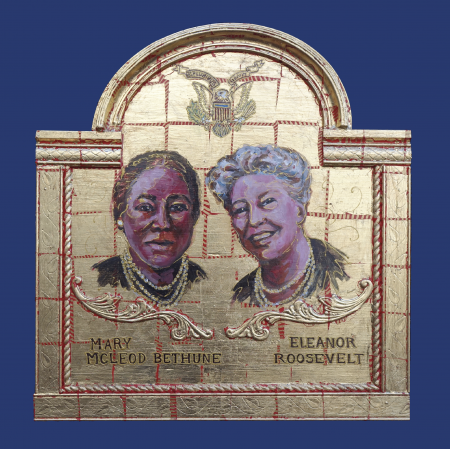“The drums of Africa still beat in my heart. They will not let me rest while there is a single Negro boy or girl without a chance to prove his worth.” – Mary McLeod Bethune
“When more whites and Negroes become friends, we shall have a much happier world.” – Eleanor Roosevelt
That these women could become friends and allies in the work for equal rights for Blacks in America coming from such radically different backgrounds is incredible. Mary McLeod was born in South Carolina in 1875 to parents who had been slaves. Working in cotton fields as a child, she was taught by some white missionaries to read. She later wrote: “The whole world opened up to me when I learned to read.” After attending Scotia College, she became a teacher. In 1898, she married, Albertus Bethune. Due to segregationist policies she was unable to become a missionary to Africa. Instead, at the age of 29, she started a school for African American girls in Daytona, Florida which soon merged with an all male school and became Bethune Cookman College. As the founder and president of the college, she became prominent in the academic world, as well as in civil rights circles as president of the National Council of Negro Women and on the Advisory Board of the National Youth Administration.
Eleanor Roosevelt was born to wealth and privilege. Theodore Roosevelt was her uncle; Franklin Roosevelt was a distant cousin. Both of her parents died when she was young. She was educated by tutors and as a teen, her grandmother sent her to school for girls in England. With a newfound self-confidence, she returned to New York, and became involved in social work, taught at the Rivington Street Settlement House and joined the Junior League. After her marriage to Franklin Delano Roosevelt in 1905, she focused on their children and her husband’s political career. In 1932 he was elected President of the United States.
Mary and Eleanor first met at a luncheon of the National Council of Women held at the New York home of Eleanor’s mother-in-law, Sara Roosevelt. When Sara noticed that Mary was the only African American present, she took her by the arm and seated her next to Eleanor at the head table. Through Sara, Mary and Eleanor became friends. As a result of this relationship, Eleanor emerged into public view as a crusader for women’s and civil rights. In 1933, Eleanor took the bold step of inviting distinguished African-American leaders to the White House. It was the first time that such a gathering of Black people were able to discuss openly issues of importance to them. She invited a growing number of Black friends to the White House. Though frowned upon by some, when Bethune came to visit, Eleanor would meet her at the gate, embrace her, walking with her arm in arm. The two women continued to work on civil rights when they convinced President Roosevelt that within the National Youth Administration a Negro Division was essential for the equal distribution of benefits. Appointed Director of the Division, Mary held the highest position in the government ever held by a Black woman.
Together they were in attendance at the formation of the United Nations in 1945 where Mary represented the NAACP and Eleanor was President Truman’s appointee to the General Assembly.

